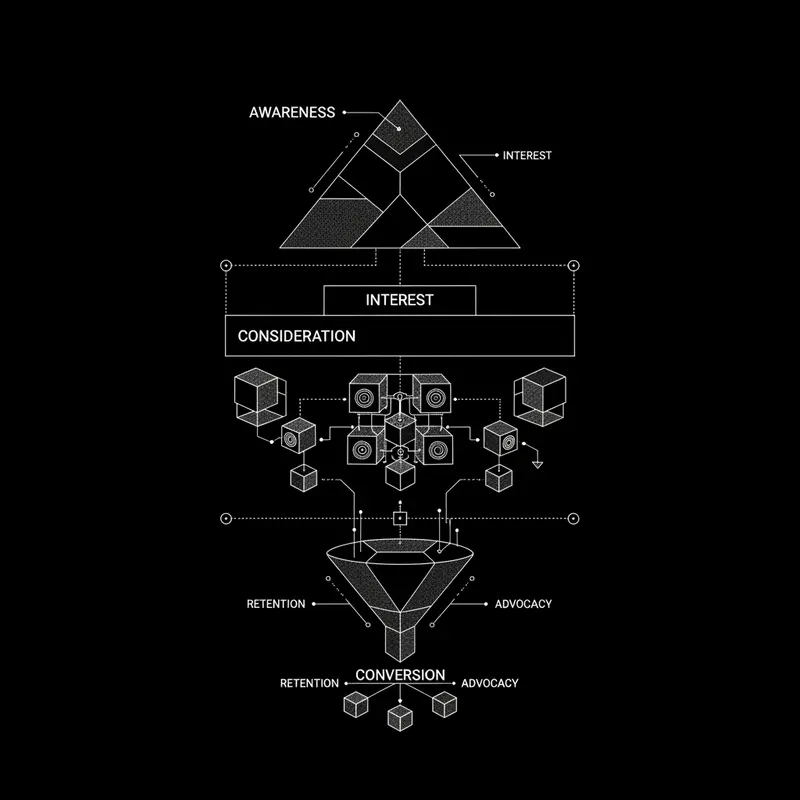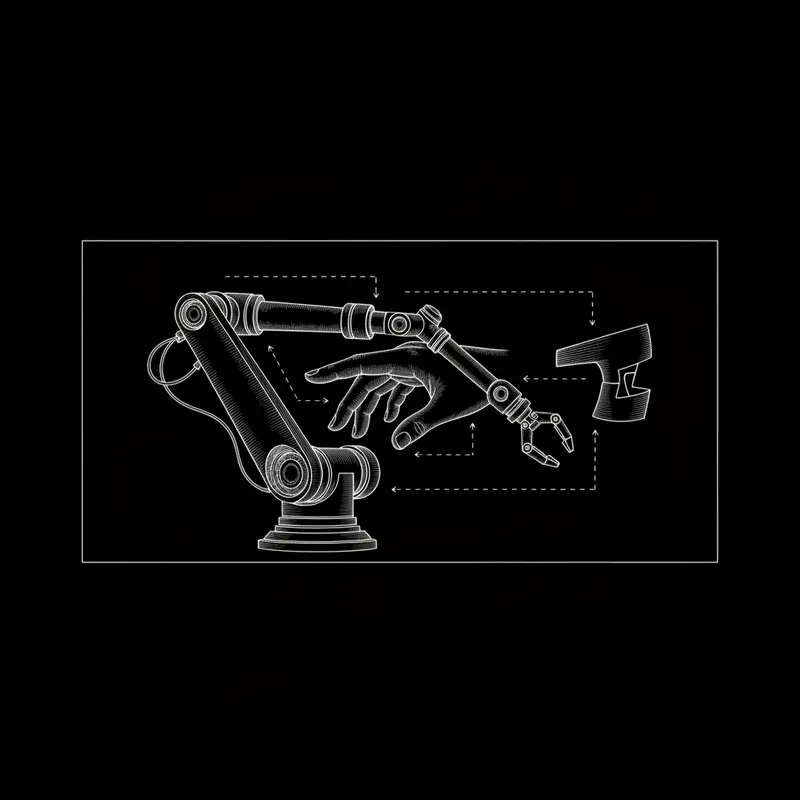
Most marketers treat AI as a content vending machine. They insert a generic prompt and expect a viral result. This is a losing game.
The machine is not a creator. It is a mirror. If you feed it average inputs, you will get average outputs. The goal is not to produce more noise. The goal is to leverage strategic intelligence to uncover deep audience insights and craft campaigns that convert.
Here is the system to shift from a content mill to a strategy engine.

You wanted leverage. You got noise.
You stare at the flashing cursor. You paste a prompt you found on a "growth hack" thread. You get back paragraphs of nothing. "Delve." "Unlocking potential." "In the evolving landscape."
It reads like wet cardboard. It feels like plastic.
This is the "Content Mill" trap. You are optimizing for volume while sacrificing the soul of the work. You are feeding the machine generic inputs and acting surprised when it spits out generic outputs.
The machine is a mirror.
If you feed it templates, which are by definition the average of past performance, you will get an average result. You are asking a calculator to paint a masterpiece using only the color beige. That is a mathematical impossibility.
To shift from a Content Mill to a Strategy Engine, you must stop treating the AI as a generator. You must start treating it as a synthesizer. You need to inject specific, painful context before you ask for a single word of copy.
Here is the shift.
1. The Audit (Isolate the Template)
Look at your last ten prompts. If they contain the words "write a viral post," "act like an expert," or "make this punchy," you are failing. These are noise signals. They tell the AI to mimic the internet's average.
Delete them.
You must strip away the command to perform and replace it with the context to understand.
2. The Map (Target the Psychographic)
Demographics are dead. Nobody buys based on their age or location. They buy based on their internal narrative.
Do not ask the AI for a post for "entrepreneurs." Ask it to build a profile for the creator who is awake at 3:00 AM, staring at the ceiling, terrified that they are just shouting into the void.
When you solve for resonance, reach becomes a byproduct.

Once you have resonance, you will generate data. But most creators treat their dashboard like a scoreboard rather than a map.
You open the laptop. You see a wall of green and red percentages. You look for validation. When the numbers go up, you feel like a genius. When they go down, you panic. This is a fragile existence.
The analytics dashboard feels like a maze because you are trying to read human behavior as a math problem. It is not. It is a psychology problem disguised as data.
Raw data is high entropy. It is chaotic. Your brain is not evolved to derive meaning from rows of CSV files. It is evolved to detect threats and opportunities through stories. When you stare at "Average View Duration," you are looking at a shadow, not the object casting it.
The error is assuming that more data leads to more clarity. But here is the truth: clarity comes from elimination.
You do not need to know everything everyone did. You need to know why a specific person stayed.
To move from confusion to clarity, we must stop acting like accountants and start acting like anthropologists. We will use AI not to count the sheep, but to understand the wolf.
We act on two specific levers to turn this data into a weapon.
1. Set Up the Insight Filter (Behavior-Based Triggers)
The first step is to ignore the vanity metrics. "Views" are ego. "Retention" is truth. You must set up an AI-driven filter that surfaces behavior-based triggers.
Now, you are not looking at a graph. You are looking at a map of human desire.
2. Synthesize Emotional Peaks (The Narrative Arc)
Once you have the triggers, you have the ingredients for the story. Data fails to convert because it lacks emotion. Stories convert because they transfer energy.
Take the behavior-based triggers identified in step one. Feed them into your system to build a narrative arc.
You are no longer guessing. You are engineering resonance based on proven behavior. The maze disappears. The path becomes clear.

Clarity is useless without velocity. This is where the amateur gets left behind.
You have likely spent the last few years treating every product launch or newsletter series as a blank canvas. You sit down. You stare at the blinking cursor. You wait for inspiration to strike. This is not a creative process. It is a torture chamber of your own design.
You pour weeks into crafting the "perfect" campaign, polishing every sentence, only for it to land with the silence of an empty room. The pain isn't just the lost time. It is the realization that you were gambling the whole time.
Manual creation is a losing game against entropy.
The market moves faster than your ability to write from scratch. When you treat marketing as art rather than a system, you introduce massive points of failure. You rely on your mood, your energy, and your limited perspective.
But here is the truth: High-performers do not write campaigns. They assemble them.
To solve the speed problem, you must stop acting like an author and start thinking like an architect. You need a Campaign Component Library.
Here is the protocol to build a high-conversion funnel without the guesswork.
You move from hoping for a winner to engineering one.

You have engineered a high-speed system. Now you face the final threat: losing your soul in the process.
The biggest issue is not that AI is wrong. It is that AI is hollow.
It produces technically correct text that misses the "subtle human connection." It misses the slang. It spits out corporate speak even when you try to be chill. It is, in the words of the market, "dumb, lol." Customers describe the output as having "no breathing" and "weird intonation." It sounds "too perfect but also totally flat."
You see this failure in real-time. Someone brings up a nuanced issue in a thread, and the bot offers a canned, "bland af" response. It confuses the audience. They ask: "Is this even our brand talking?"
Authenticity cannot be automated.
But here is the truth.
The failure is not in the model. The failure is in your lack of architecture. You are treating AI as an autonomous driver when it is actually a "digital chisel." It requires a human artist.
Brand voice is not "learned" by the software. It is architected by you. Human oversight is not a bottleneck to scale. It is the "catalyst for acceptance." If you do not edit the output, you get limited value. The goal is not to make the AI sound "human." The goal is to make it sound like you.
You need to engineer a soul into the machine. Here is the protocol.
Stop using vague adjectives. Define 3-5 core voice attributes (e.g., Helpful, Clear, Empathetic). Create a Voice DNA Document. For each attribute, you must write:
Include a lexicon blacklist. If you don't want the AI to sound like a LinkedIn influencer, ban the words that make it sound like one.
You cannot optimize what you cannot measure. Generate a baseline of 50-100 outputs covering all touchpoints: emails, DMs, and edge cases like refunds or technical crises.
Recruit three humans: a brand manager, a copywriter, and a customer service lead. Have them independently rate every output using your new rubric.
Lock your team in a room for a 90-minute calibration session. Review every disagreement. Refine the definitions until you achieve 80%+ inter-rater agreement.
From this chaos, extract order. Select the 20-30 outputs that scored a perfect 5/5 across all dimensions. This is your Golden Set. These are the non-negotiable style benchmarks that all future instantiations of your AI must match.
Deploy, but do not look away. Implement an active learning pipeline.
Flag low-confidence outputs (<70%) and high-stakes scenarios (VIP customers, crisis comms) for priority human review. Feed these explicit ratings back into the RLHF reward model.
Voice is not a setting. It is a discipline.
The era of 'more content' is over. The era of 'strategic resonance' has begun. You now have the protocols to audit your inputs, translate your data, assemble your campaigns, and codify your soul. The machine is waiting. Do not let it run on autopilot.
Join The Deep Game Newsletter to download the full Voice DNA Template.
We help creators build high-leverage businesses using strategic systems.
The Enhanced Marketer Letter is your monthly dose of:
🚀 Cutting-edge AI marketing tactics
💡 Insider tips from my $17M+ campaign experience
🔬 Results from my latest AI experiments
🧠 Mind-bending ideas to inspire your next breakthrough
Don't let your competition outpace you in the AI revolution. Level up your marketing game today!